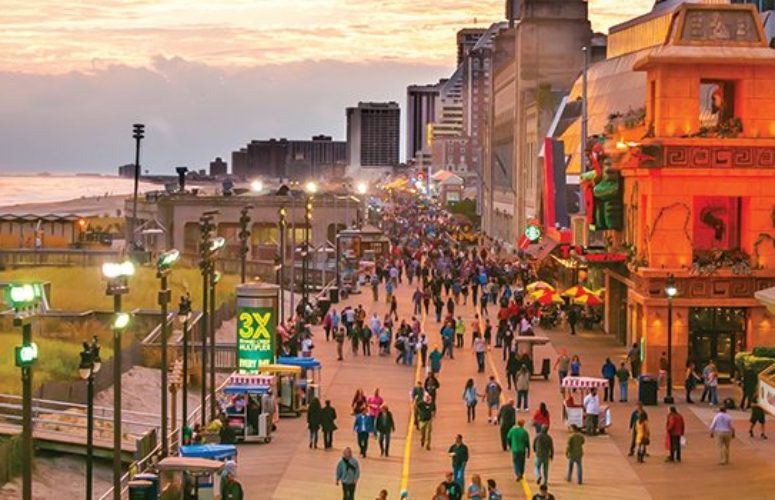
Are the Odds Turning in South Jersey’s Favor?
Spurred by the state’s Grow New Jersey program and convention business boost in Atlantic City, Southern New Jersey’s economy is starting to sizzle.
By Jennifer L. Nelson, Contributing Writer On Sep 28, 2015Though much of the news coming out of South Jersey revolves around the economic devastation brought forth by the recent casino closures in the state’s gambling and entertainment capital, a closer look suggests that an abundance of significant projects will continue to bring economic growth and development to the South Jersey region in the coming months – including Atlantic City.
In fact, new data shows that four of the eight remaining casinos in Atlantic City collected more in gambling winnings in June than they did in the same month one year ago. The city’s overall winnings may still be down by 8.2 percent, but that doesn’t mean the city is down for the count. Convention business in Atlantic City is booming, with a 37 percent increase since last year in room nights booked. Additionally, nearly 120,000 rooms are booked for conventions as far out as 2022 – with a 40 percent increase in conventions booked through 2020 – during the first six months of this year. And that’s due, in large part, to organizations like Meet AC, a non-profit alliance that is hard at work marketing the city as more than just a gambling destination. It is promoting everything Atlantic City has to offer, from concert venues to meeting space.
“From an occupancy standpoint, Atlantic City has actually been doing extremely well,” says Jim Wood, president and CEO of Meet AC. “We’re also seeing revenue growth in the remaining casinos, which is hopefully a good sign of things to come and an indicator that things are turning around for Atlantic City.” In the meantime, the city is actively trying to promote its non-gambling offerings and draw a wider range of visitors through massive construction projects, including The Playground, a $52-million entertainment complex targeted toward the 21-to-40 year old demographic. The Playground, located on the former site of the Pier Shops at Caesars, will create some 400 jobs, and include five live music venues, a concert space, sports bar, bowling alley, outdoor pool and outdoor concert venue on the beach.
The former Atlantic Club casino, meanwhile, will be converted into a family-focused venue that will have 800 guestrooms and an 81,000-square-foot waterpark. Endeavor Property Group is heading up the estimated $150-million to $165-million project, which received zoning-related approvals by the Casino Reinvestment Development Authority (CRDA).
The Borgata also opened its own $14-million Festival Park, an entertainment venue that can accommodate 4,500 people. “It will have a significant impact on attracting millennials, and it’s all part of Atlantic City’s move to diversify its offerings and grow its non-gaming business,” Wood explains. “This way, Atlantic City can offset some of its gaming losses by reaching younger audiences through its entertainment offerings, while, at the same time, attracting more business customers into its properties for meetings and conventions, especially on weekdays.”
To that end, Harrah’s Hotel and Casino has plans to open a new $127-million Waterfront Conference Center this September, which will include two 50,000-square-foot ballrooms, and Resorts International constructed a 12,000-square-foot conference center. “Harrah’s will drive new convention business and revenue into its facility, and Resorts is also pursuing more non-gaming business by adding meeting space to capture more of the convention market segment,” Wood notes.
But Atlantic City isn’t the only South Jersey municipality that’s making great strides in boosting both the local and statewide economies. Camden is quickly becoming the most talked about municipality in South Jersey for its transformation from a challenged urban city into a bustling hub for job growth and economic development. Among its most significant economic development news was the recent announement of a new Philadelphia 76ers 110,000-square-foot practice facility in the city, which joins projects such as a new Rutgers nursing school, Subaru of America moving its headquarters to Camden, and most recently, the groundbreaking for Holtec International this summer. “There are a lot of incredible economic development projects happening in the city, which are putting Camden in the position to once again become a regional hub for South Jersey,” says Camden Mayor Dana L. Redd.
Throughout South Jersey, initiatives such as the state’s Grow New Jersey program are also playing a crucial role in continuing to build up cities like Camden. According to Rebecca Ting, an office sales and leasing specialist for NAI Mertz, the Grow New Jersey Program has been one of the most significant initiatives in the region to spur the retention of numerous companies in New Jersey, in addition to attracting new corporations and adding to the number of jobs to the region. “New Jersey is really on fire with its incentive programs … they’ve been really good for the entire South Jersey region,” Ting asserts.
In Burlington County, for example, the Destination Maternity Corporation has relocated its corporate headquarters and distribution center from Philadelphia to South Jersey, with offices in Moorestown and a warehouse in Florence. “Astute developers are making use of the program to attract and retain companies to the area,” Ting adds. “The aggressive efforts of the state, through the Grow New Jersey program, have made New Jersey a friendlier and easier place to relocate.”
Camden continues to be a shining example of the power of economic partnerships. Late last year, the New Jersey Economic Development Authority (EDA) approved a $107-million tax break to facilitate the move of some 250 Lockheed Martin employees to Camden, while the Philadelphia 76ers is receiving $8.2 million in grants over the next 10 years to offset the projected cost of its new facility, which will create 250 new non-construction jobs. “We are enjoying the support of many partners at all levels of government, but also in the private sector to continue Camden’s transformation and create a robust economy in our city,” Redd says. “Our city is taking advantage of tools such as the state’s Economic Opportunity Act to lure and attract businesses to Camden and facilitate job retention as well as create new jobs, but we are also focusing on building human capacity by training our residents to prepare for the jobs that will soon be available right here. There’s a lot to be excited about.”
In addition to the state programs, local economic development teams, such as those in Woodbury, have also been aggressive in developing new marketing initiatives for their respective towns, such as the construction of the B Well Rehabilitation facility at the former Woodbury Country Club. This multi-million-dollar investment will include three medical-based buildings, 18 market rate houses, and an additional 15 acres will be donated back to the city for open public space. The project promises to bring upwards of 200 new jobs to Gloucester County.
“I feel the South Jersey region has heated up with the efforts of local and regional economic development agencies,” Ting says. “Sections of Cherry Hill have also become hot spots due the redevelopment initiatives implemented, and an ‘open for business’ attitude from local officials.”
Throughout the region, local firms such as South Jersey Gas are also doing their part to brighten the region’s economic future. “The biggest thing we always try make people aware of is just how much utility companies in the state invest, which of course creates jobs and keeps our local residents working,” explains Jeffrey DuBois, president of South Jersey Gas. By the end of 2015, the utility will have spent over $900 million in five years on local development projects, including investing in its own facilities to support job growth.
But the exciting economic development projects in South Jersey don’t end there. Gloucester County is also taking full advantage of the Economic Opportunity Act, which has spurred more than $40 million in investments in the county, according to Gloucester County Freeholder Director Robert M. Damminger. Gloucester’s Economic Opportunity Act projects range from $22 million for Nexus Properties in Glassboro, a mixed-use, six-story building that provided 400 construction jobs and will create 100 full-time positions upon completion, to Coperion K-Tron, a manufacturing company in Pitman, with a $5-million award to retain 152 jobs and create approximately 20 new jobs.
“The Economic Opportunity Act really has been a game changer for all of South Jersey,” agrees Debra P. DiLorenzo, president and CEO of the Chamber of Commerce for South Jersey.
Additionally, Nemours Children’s Health System is building a 63,500-square-foot medical facility in Deptford that will employ approximately 60 people; Food Comm International built a 123,000-square-foot building to hire approximately 50 employees in Logan Township; South Jersey Bakery is building a 40,000-square-foot food manufacturing facility in West Deptford with approximately 50 new hires; and Amazon built a 190,000-square-foot sortation facility in Logan Township, which will employ anywhere from 300 to 600 seasonal employees. “Positive signs of economic stability and growth are most noticeable in the Gloucester County industrial and commercial markets, which have substantially improved over the last five quarters – this year, 486,000 square feet of new construction was built throughout the county,” Damminger says. “Currently, we have more projects that are under construction and will add an additional half million square feet of industrial space to the county, and all while bringing in new businesses and creating new job opportunities for residents in 2015.”
Among the most significant projects is the ongoing construction of the Paulsboro Marine Terminal; only three months after Holt Logistics Corp announced its partnership with the South Jersey Port Corporation to construct a state-of-the-art terminal at the Port of Paulsboro, NMLK Steel agreed to become its first tenant. The announcement will equate to the creation of upwards of 100 permanent jobs. “The economy is ticking up, and we are positioned to be at the front of the pack with modern ports and facilities that create and sustain jobs for our residents and the region,” Damminger says.
Gloucester County has also been teaming up with its colleges and universities to provide job training and educational programs for students in a variety of areas, including STEM (science, technology, engineering and math), logistics, business and the medical sciences. “Through a partnership with Rowan University, the county is focused on ensuring that all the money that’s invested in our children through their primary education – the main source of property tax dollars – remains right here in Gloucester County and New Jersey by providing them with an excellent, accessible education and a workplace where they can prosper when they graduate,” Damminger says.
Additionally, Rowan University is experiencing massive growth, and has responded by making a hefty investment in capital projects of its own. The university is on track to have more than $550 million worth of construction taking place over the next five years, including new buildings for its colleges of business and engineering, a new 1,400-bed residence hall, a new art gallery in the historic downtown district of Glassboro, and an addition to its academic center in Camden. “It has always been our goal to maintain very close collaborations with local business – if we prosper, our students prosper, our local community prospers, and the entire state prospers,” asserts Ali A. Houshmand, president of Rowan University. “It’s strategic, serious and present in everything we do as a university, and we believe it’s the best way to build a model of how today’s higher education should operate.”
Among Rowan’s biggest developments is a new $300-million public/private partnership called Rowan Boulevard, a new mixed-use roadway featuring residence halls, a Courtyard Marriott, a Barnes & Noble bookstore, classroom space, retail stores and eateries. “Our approach to managing the university revolves around our collaborating with all aspects of industry, and our willingness to partner with businesses is doing something amazing: spurring economic development throughout the region,” Houshmand adds. “We’re offering a high-quality education to students and also creating new opportunities to remain involved and engaged with the community.”
Rowan joins several institutions of higher education that are investing in the future of South Jersey by enhancing its offerings for the next generation of employees.
A joint initiative that includes Cumberland County College, the Cumberland County Board of Chosen Freeholders and the Cumberland County Improvement Authority is paving the way for the county’s Center for Workforce and Economic Development, a $7.7-million, 30,000-square-foot facility on the Cumberland County College campus in Vineland. A 200,000-square-foot full-time technical education center and high school on campus is also being built on the campus, as well as the new Arts and Business Innovation Center for the college in Millville. “Education and training is our number one initiative to help improve the economy by preparing students for the high-tech jobs of the future,” says James B. Watson, director of the Cumberland County Improvement Authority.
Looking ahead, the future of South Jersey looks bright, thanks to the commitment of government agencies and dedicated local leaders to continue investing in the region. “All of our economic development projects are sending a strong message to the entire region of South Jersey that things are starting to turn around,” Redd concludes. “I’ve never seen such momentum and energy in the city of Camden … South Jersey residents are seeing the construction happening right before their eyes, and realizing that when we make an announcement, a shovel goes into the ground and we continue to build for our future.”
Related Articles:






